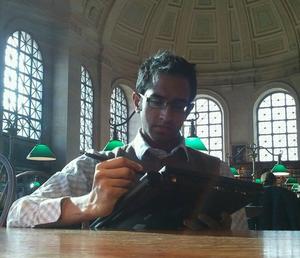ESP Biography
VIJAY NARASIMHAN, Lights! Materials Science PhD Student
|
Major: Materials Science & Engineering College/Employer: Stanford Year of Graduation: G |

|
Brief Biographical Sketch:
As a Fulbright Scholar at Stanford University, Vijay Narasimhan is conducting doctoral research on enhancing light absorption in solar cells and camera sensors. Mr. Narasimhan holds a Bachelor's in Computer Engineering from the University of Ottawa and a Master's in Nanotechnology from the University of Cambridge. Through his research, Vijay has studied the interaction of light and matter, advanced microscopy, and image processing techniques. As a young engineer in industry and as an entrepreneur, Mr. Narasimhan has a history of developing commercially relevant technology. He has produced several conference papers and a patent application based on his work on solar power and energy-efficient antennas. Vijay is also a community builder, supporting educational opportunities for children through fundraising and outreach activities. In his spare time, Vijay enjoys biking and eating chocolate and cheese. Past Classes(Clicking a class title will bring you to the course's section of the corresponding course catalog)P4283: Dreaming in Color: The Science of Light and Matter in Splash Spring 2015 (Apr. 11 - 12, 2015)
Why is the sky blue? Why do leaves change colors in the fall? How can you tell the color of dinosaurs just from their fossils? How can the metal gold become green, blue, or red?
In this interactive class, you’ll discover the answers to questions like these with demonstrations and hands-on activities. You’ll also find out how the answers to these questions are helping scientists and engineers discover more about outer space, create more efficient solar cells, and treat cancer.
P3195: Dreaming in Color: The Science of Light and Matter in Splash! Fall 2013 (Nov. 02 - 03, 2013)
Why is the sky blue? Why can’t you see your cell phone screen while wearing sunglasses? How can you tell the color of dinosaurs from fossils? How can a peacock disguise itself by taking a bath? How can you make something black just by making it rougher? When is gold green, blue, or purple?
In this interactive class, you’ll discover the answers to questions like these with demonstrations and hands-on activities. You’ll also find out how the answers to these questions are helping scientists and engineers discover more about outer space, create more efficient solar cells, and treat cancer.
P2163: Dreaming in Color: The Science of Light and Matter in Splash! Spring 2012 (Apr. 21 - 22, 2012)
Why is the sky blue? Why can't you see your cell phone screen while wearing sunglasses? How can you tell the color of dinosaurs from fossils? How can a peacock disguise itself by taking a bath? How can you make something black just by making it rougher? When is gold green, blue, or purple? Can you identify a material by setting it on fire?
In this interactive class, you'll discover the answers to questions like these with demonstrations and hands-on activities. You'll also find out how the answers to these questions are helping scientists and engineers discover more about outer space, create more efficient solar cells, and treat cancer.
E1419: The Science of Spectacular Photographs in Splash! Spring 2011 (Apr. 16 - 17, 2011)
Why don’t your vacation photos wind up on the cover of National Geographic? You could blame it on your crummy camera, or you could learn to take better photos with science.
Can you make the sky look more blue? Why are night photos so grainy? How can you make a blurry image sharper?
In this course, we explore the physical phenomena behind taking a great photo. Students will learn about light, color, digital cameras, and image manipulation with demonstrations and experiments.
S812: The Science of Spectacular Photos in Splash! Spring 2010 (Apr. 17 - 18, 2010)
Why don't your vacation photos wind up on the cover of National Geographic? You could blame it on your crummy camera, or you could learn to take better photos with science.
Can you make the sky look more blue? Why are night photos so grainy? How can you make a blurry image sharper?
In this course, we explore the physical phenomena behind taking a great photo. Students will learn about light, color, digital cameras, and image manipulation with demonstrations and experiments.
**Want your photo used in a demo? Send it to scienceofphotos@gmail.com
|
|
